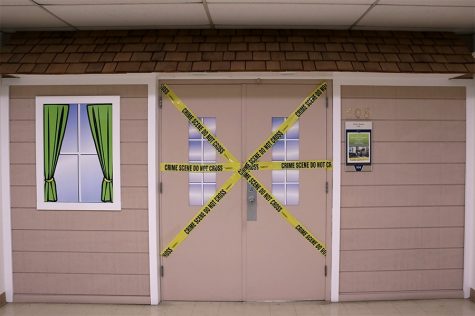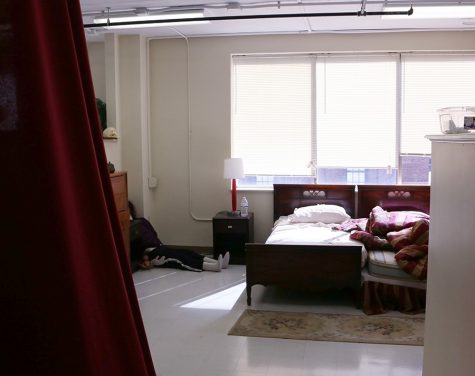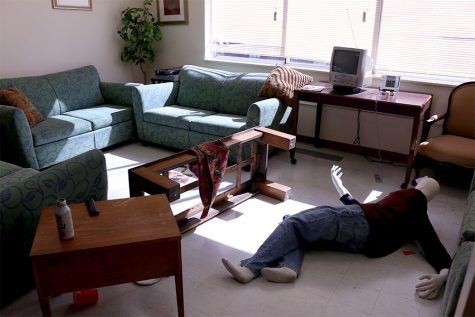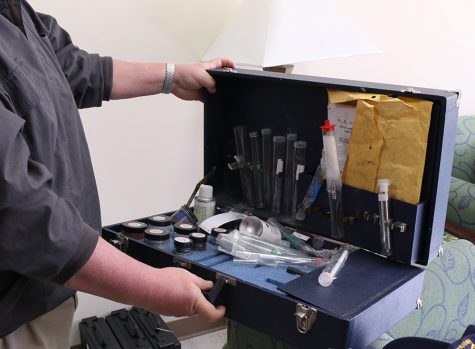CSI Point Park: an inside look at the crime scene lab
April 4, 2017
Academic Hall classrooms can normally be seen filled with living, breathing humans, but 508 Academic is the opposite.
This classroom is specifically designed for students to study the deceased… or, in this case, dummies.
“This allows anyone who is going into criminal justice, forensic science or law to actually have an idea of what it’s like to step onto a crime scene,” Assistant Professor of forensic science Edward Strimlan said.
The classroom (coined the crime scene lab) is structured to look like a house on the exterior, fully equipped with a window and set of double doors covered with crime tape.

Entering the room, with a partial shingled roof passing overhead, reveals a full classroom to the right surrounded by a red curtain. Hidden behind the curtains are three rooms set-up to mimic different crime scenes for forensic science students: a living room, a bedroom and a study.
In addition to each room having furniture, a dummy acting as the victim is present in every room. The dummies are fully clothed, but lack any fake blood remnants. Instead, the blood is described by pieces of red construction paper to salvage the dummies.
Inside of the lab, the study houses drawers of different materials such as test tubes, fake blood splatter and other props used for the crime scenes.
Each room can be customized to create a different crime scene to be investigated by the forensics students.

Sophomore forensic science majors Sarah Lukaszewicz and Sarah Berardelli said that Strimlan likes to throw obscure items in the crime scenes to throw them off course. Berardelli recalls a pinecone that was sitting on a table in one of the scenes.
“It was just sitting in the middle of room,” Berardelli said. “We kept asking ‘Where did the pinecone come from? Did it come in through the window? Does that mean that someone was able to climb through the window to get out?’ Those are the things we need to think of.”
The placement of random, obscure objects is part of Strimlan’s teaching that even when investigating, not every thing at a crime scene is evidence.
“If I went into your room, would I understand everything I see?” Strimlan said. “No. That’s what [the students] need to know.”
Strimlan said the crime scene lab is an asset for the major because it provides hands-on, real life experiences. Prior to becoming a professor at Point Park in 2011, Strimlan served as the the former Chief Forensics Invesigator for Allegheny County’s Office of the Medical Examiner.
“I was on over 2000 death scenes,” Strimlan said. “This room is no different than anyone’s house. Whether you died at home or at work…this is real life. [The crime scene lab] is as close as you can get to being real except someone hasn’t lived here for long enough.”

Inside the lab, students have to not only examine the crime scene, but also collect evidence, photograph the scene, measure, draw rough sketches of scenes, and even create their own scenes.
Students who take different forensic courses such as Development of the Death Investigation System and Forensics Evidence I and II have the ability to use the crime scene lab as a classroom.
Point Park students are not the only ones with access to the crime scene lab. In the past, the space has been used by neighborhood watch groups sponsored by different police forces, both Boy Scouts and Girl Scouts, an annual Crime Scene Investigation camp over the summer and other community events.
“It’s easier to see in an actual setting than it is to do in an actual classroom. It gives us more of a visual learning experience,” Lukaszewicz said.
Berardelli, stated that a common issue amongst the forensic science program is known as the “CSI” effect.
“People come in thinking that [forensic science] is going to be like a TV show, but it’s not,” Berardelli said.
Some examples of the realities of forensic science include the process of collecting DNA. Berardelli said in TV shows, DNA collection take a day, but in real life, the process can take up to weeks or months.

“It’s not like you can say, ‘hey, this is this person’s DNA’, the only way you can be able to say that is if it’s in a system,” Berardelli said. “There’s only certain people in the system… Most likely you’ll never get someone that has their DNA in it, so you have to test it against everyone.”
In the future, Strimlan would like to see an outside feature added to the program that the current space lacks.
“You have to be able to adapt,” Strimlan said. “Outdoor scenes happen all the time. Bodies get moved. At least with the indoor part, it’s controlled… It gives you the basics and that’s what you need.”




















pedro • Jun 24, 2018 at 4:29 AM
thanks